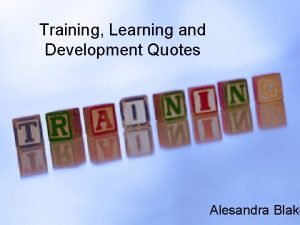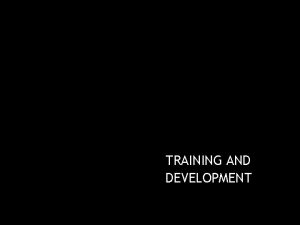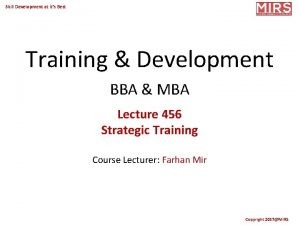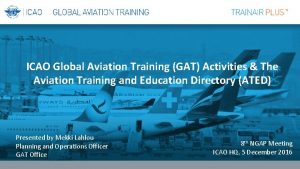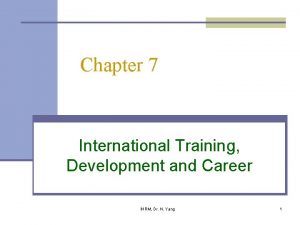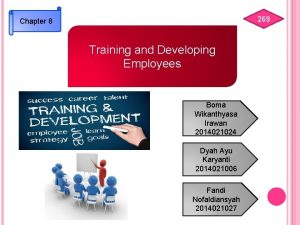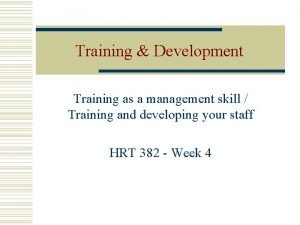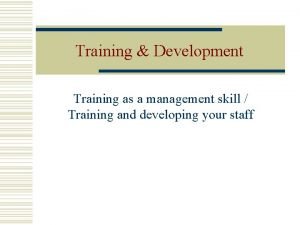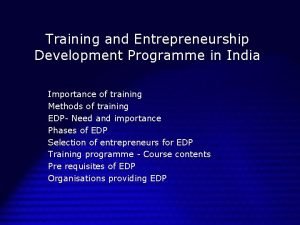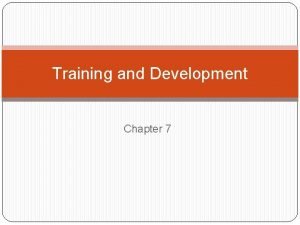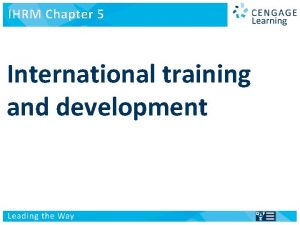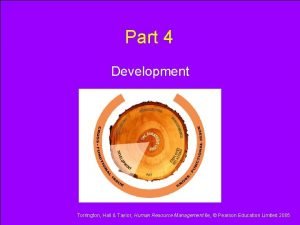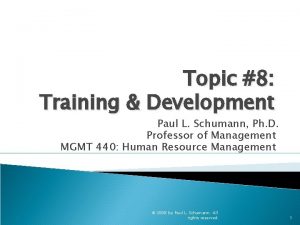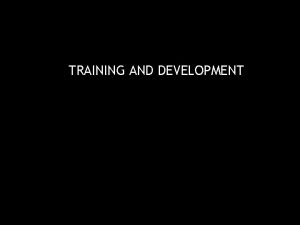Topic 8 Training Development Paul L Schumann Ph








































- Slides: 40

Topic #8: Training & Development Paul L. Schumann, Ph. D. Professor of Management MGMT 440: Human Resource Management © 2008 by Paul L. Schumann. All rights reserved. 1

Outline �Training & Development �Training Cycle �Step 1: Needs Analysis (Needs Assessment) �Step 2: Design & Develop Training Program �Step 3: Deliver the Training �Step 4: Training Evaluation 2

Training & Development �What is training? What is development? �Training: enhances the capabilities of an employee to perform his or her current job �Focuses on the current job � Examples for a bank teller: � Training program to correctly identify counterfeit currency � Training program in the bank’s new computer system used by tellers to process customer’s transactions 3

Training & Development �Development: enhances the capabilities of an employee to be ready to perform possible future jobs �Focuses on future jobs � Developmental education programs � Examples for a bank teller: � Bank sends the teller to a day-long workshop on “Emerging Issues in Finance & Banking” � Bank pays for the employee to get his or her MBA degree � Developmental job experiences � Examples: job rotation or job enlargement � Developmental interpersonal relationships � Example: mentoring 4

Training Cycle Source: Fisher, Schoenfeldt, & Shaw (2006), Figure 9. 1, p. 377 5

Step 1: Needs Analysis/Assessment �Goal of needs analysis: Identify training needs �Summary of Needs Analysis: � 3 Levels of Needs Analysis: � Organizational analysis � Job and task analysis � Individual analysis �Training Objectives 6

Needs Analysis � 3 Levels of Needs Analysis: �Organizational analysis: What are the training needs of the organization? � What training will support the organization’s strategy? � Example: Internal growth strategy (growth from new products or new markets) would be supported by training in: � Creative thinking � New product development � Understanding & evaluating potential new markets � Technical competence in jobs � Example: What are the training needs for other strategies? � Low-cost leadership, focused (niche) concentration, external growth (mergers & acquisitions), downsizing & divesting 7

Needs Analysis � 3 Levels of Needs Analysis (more): �Organizational analysis (more) � What training will support the organization’s culture, goals, & priorities? � Some organization’s emphasize training more than others � Learning organization: use training linked to strategic goals as a source of competitive advantage � Features: Learning culture, valuing employees, flexibility & experimentation, continuous learning, critical thinking, knowledge generation & sharing � What’s your training budget? 8

Needs Analysis � 3 Levels of Needs Analysis (more): �Organizational analysis (more) � Use benchmarks of organizational health & success to identify training needs � General examples: � Headcount � Productivity � Costs � Quality � Specific examples for an airline: � On-time rates � Lost baggage rates � Employee injury rates 9

Needs Analysis � 3 Levels of Needs Analysis (more): �Job and task analysis: What are the training needs of each job in the organization? � Examine the job descriptions: � What tasks & duties are performed by each job? � For each task: � Do new hires already know how to perform the task or will they have to be trained? (Helps to identify training needs) � What are the consequences of performing the task incorrectly? (Helps to set training priorities) � Can the task be learned on the job, or should it be taught off the job? (Helps to identify training methods) 10

Needs Analysis � 3 Levels of Needs Analysis (more): �Individual analysis: What are the training needs of each individual employee in the organization? � Examine each employee’s performance appraisal � Do certain employees, or groups of employees, have job performance that might be improved by training that is costeffective? 11

Needs Analysis �Training Objectives: Use the 3 levels of needs analysis to establish the training objectives for the training program �Training objectives answer the question: What will employees be able to do as a consequence of the training? � Make the training objectives specific, concrete, & measurable � Example for a bank teller training program in detecting counterfeit currency: � Identify counterfeit currency correctly 100% of the time � Example for a bartender training program on underage consumption: � Check customer’s age, refuse service, and report attempts at underage consumption correctly 100% of the time 12

Training Cycle Source: Fisher, Schoenfeldt, & Shaw (2006), Figure 9. 1, p. 377 13

Step 2: Design & Develop Training Program � 3 Stages of Learning: Design the training program to move employees up to Stage 3 �Stage 1: Declarative knowledge (cognitive phase) � Learn facts & concepts � High demands on memory & attention � Performance is slow & halting � Errors are common �Stage 2: Knowledge compilation (associative phase) � Facts & behaviors get “chunked” into a routine � Performance begins to improve � Reduced concentration is required 14

Design & Develop Training Program � 3 Stages of Learning (more): �Stage 3: Procedural knowledge (autonomous phase) � Performance becomes automatic � Performance is fluid & correct � Little conscious concentration is required �But if we want to design our training program to move the trainees up to Stage 3, how do we do that? � The answer involves putting together the following concepts 15

Design & Develop Training Program �Preconditions for learning: Design the training program to satisfy 2 key preconditions: �Trainee readiness: What do the trainees already know? � We want to start the training program at the right level � We need to find out what they already know � Example: Does our newly hired bank teller know how to count money? � Design the training program to build on what the trainees already know 16

Design & Develop Training Program �Preconditions for learning (more): �Trainee motivation: Are the trainees motivated to learn? � Involve employees in the needs analysis � Show trainees how the training will enhance their job performance & their careers � Use goal setting: � Establish specific, concrete, & measurable training goals � Make the goals difficult but achievable � Set intermediate & end goals � Build strong self-efficacy expectations: beliefs about success � Persuasion: “You can do it!” � Modeling: show trainees successful previous trainees � Enactive mastery: lead trainees to early success in training 17

Design & Develop Training Program �Practice: “practice makes perfect” �One critical key to moving to Stage 3 of learning is providing the trainees with the right kinds of practice Take into consideration the task complexity: � Simple task: practice the entire task � Complex task: � Break the complex task into simple pieces � Practice each of the simple pieces � As performance improves, combine the simple pieces and practice the entire complex task � Distributed practice sessions work better than a massed practice session: spread the practice sessions out over multiple days with sleep between the practice sessions � Overlearning is good: keep practicing well beyond the point of correct performance of the task � 18

Design & Develop Training Program �Knowledge of results: feedback is important �Provide lots of feedback & encouragement, especially early in training Helps build self-efficacy expectations � Guide the trainee to correct performance � �As performance improves, raise the performance level required for positive feedback � Encourage the trainee to strive for better performance �Show trainees how to evaluate their own performance � Allows trainees to determine for themselves how they’re doing �Gradually shift from trainer-provided feedback to the trainee’s own self-generated feedback � Prepares the trainee to correctly use the training on the job without the close supervision of the trainers in the training program 19

Design & Develop Training Program �Overcome interferences: identify& resolve things that might interfere with learning �Distractions in the training environment � Lighting problems � Noise problems � Temperature problems, etc. �Bad habits that the trainees bring with them into training � Identify the bad habits of the trainees early in training � Correct the bad habits early in training so that the trainees practice the correct way, and not the wrong way 20

Design & Develop Training Program �Transfer of training: structure the training program to enhance the transfer of training from the training program back to the job �Make the training setting similar to the work setting � Use the same equipment & processes in training that are used on the job �Teach both tasks & principles � Both how to do the task and why it is done that way �Overlearning is good: provide lots of practice �Use a variety of job-relevant examples 21

Design & Develop Training Program �Transfer of training (more): �Show the trainees the relevancy of the training to their jobs �Build positive self-efficacy expectations �Ask trainees to develop their own action plan with goals for how they will use the training on their jobs �Relapse prevention: ask trainees to anticipate what might cause them to relapse to their bad habits, and to develop their own plans to avoid the relapse 22

Design & Develop Training Program �Transfer of training (more): �Provide pre-planned opportunities for trainees to use their new skills on their jobs �Supervisors and co-workers should support the new behaviors back on the job �Train a team together as a team �Give homework assignments that require trainees to apply what they are learning in training to their jobs �Provide reminders (job aids) for trainees to take back with them to their jobs 23

Design & Develop Training Program �Training Methods: decide which training method to use �On-the-job training (OJT): training is at the actual work site using the actual work equipment Advantages: � Enhances the transfer of training: the training setting and the work setting are the same � May reduce costs: avoid the cost of a separate training facility � Enhances trainee motivation: job-relevancy of training is more obvious to the trainees � Disadvantages: � May be disruptive to normal operations � May have more distractions that interfere with learning � May have safety concerns � 24

Design & Develop Training Program �Training Methods (more): �Off-the-job training: training takes place off the job at a training facility designed for training Advantages: � Avoids disruptions to normal operations � Minimizes distractions � Avoids safety concerns � Disadvantages: � Transfer of training may be more difficult due to differences between the training setting and the work setting � Costs may be higher due to the cost of the training facility � Trainee motivation may be reduced because the job-relevancy of the training is not as obvious � 25

Design & Develop Training Program �Training Methods (more): �Off-the-job training (more): � Off-the-job training techniques: � Lectures � Discussions � Cases � Role-plays � Simulations �Example: How should we set up a training program for newly hired bank tellers to teach them how to do their job? On-the-job or off-the-job? 26

Training Cycle Source: Fisher, Schoenfeldt, & Shaw (2006), Figure 9. 1, p. 377 27

Step 3: Deliver the Training �Deliver the training that was planned 28

Training Cycle Source: Fisher, Schoenfeldt, & Shaw (2006), Figure 9. 1, p. 377 29

Step 4: Training Evaluation 4 Levels of Evaluation (Kirkpatrick, 1983) Level 1: Reaction: measure the satisfaction of the trainees with the training program Satisfaction questionnaire Level 2: Learning: measure how much the trainees have learned Written tests Performance tests Simulation tests Source of figure: Fisher, Schoenfeldt, & Shaw (2006), Figure 9. 4, p. 405 30

Step 4: Training Evaluation 4 Levels of Evaluation (more) Level 3: Behavior: measure the trainees’ job performance back on their jobs Performance appraisals Level 4: Results: measure the impact on the organization Profits Costs Productivity Quality Injury rates, etc. Source of figure: Fisher, Schoenfeldt, & Shaw (2006), Figure 9. 4, p. 405 31

Training Evaluation �Evaluation designs: when do you collect data on reactions, learning, behavior, and results? �One-shot posttest-only design: measure when training is finished: TRAIN → MEASURE � Makes sense for Level 1 (Reaction) � Ask the trainees to complete the satisfaction questionnaire at the end of the training program � But it’s a poor design for the other levels of evaluation � There’s no comparison group � We wouldn’t know if learning, behavior, and results have changed for the better because of the training program 32

Training Evaluation �Evaluation designs (more): �One-group pretest-posttest design: measure both before and after training: MEASURE → TRAIN → MEASURE Compute the change in the measures: � Learning: Did the percentage correct on the test go up? � Behavior: Did the employee’s job performance improve? � Results: Did the company improve (profits, costs, etc. )? � Weakness: We’re not sure if the training is the only thing that might have caused the measures to improve � There might be other things that happened at the same time as the training that also affects employee behavior (job performance) and corporate results (profits, etc. ) � 33

Training Evaluation �Evaluation designs (more): �Pretest-posttest control-group design: compare the changes in a control group to the changes in the training group Control: MEASURE → NO TRAIN → MEASURE Training: MEASURE → TRAIN → MEASURE Randomly divide employees into 2 groups: � Control group: does not get training � Training group: does get training � Measure learning, behavior, & results in both groups before and after training is provided to the training group � Compute the changes in the measures for both groups � Did the training group improve more than the control group? � Learning (test scores), behavior (job performance), & results (profits, costs, etc. ) � This is the strongest evaluation design � 34

Training Evaluation �Example: Sales training program to help our salespeople increase sales �Training Group: randomly select some of the salespeople to be in the training program �Control Group: the other salespeople are in the control group that doesn’t receive training (at least initially) �Level 1 Evaluation: Reaction � One-shot posttest-only design: administer in the training group at the end of the training a questionnaire that measures the satisfaction of the trainees with the training program 35

Training Evaluation �Example: Sales training (more) �Level 2 Evaluation: Learning � Pretest-posttest control-group design: Control: MEASURE → NO TRAIN → MEASURE Training: MEASURE → TRAIN → MEASURE � Develop a test that measures the extent to which individuals have achieved the learning objectives of the training program � Before providing the training to the training group, administer the test to both the control and the training groups � After training the training group, administer the test to both the control and the training groups � Compare the average change in the test scores in the control group to the average change in the test scores in the training group 36

Training Evaluation �Example: Sales training (more) �Level 3 Evaluation: Behavior � Pretest-posttest control-group design: Control: MEASURE → NO TRAIN → MEASURE Training: MEASURE → TRAIN → MEASURE � Use the organization’s performance appraisal system to measure the job performance of the salespeople � Example: amount of sales, customer satisfaction ratings, etc. � Before providing the training to the training group, measure the job performance of each salesperson in both the control and the training groups � After training the training group, measure the job performance of each salesperson in both the control and the training groups � Compare the average change in the job performances in the control group to the average change in the job performances in the training group 37

Training Evaluation �Example: Sales training (more) �Level 4 Evaluation: Results � One-group pretest-posttest design: MEASURE → TRAIN → MEASURE � Measure organizational results before training the training group � Measure organizational results after training the training group � Compute the change in organizational results � Organizational results could include anything that the training might affect: profits, costs, productivity, injury rates, quality, employee morale, etc. � Pretest-posttest control-group design might be possible if the organization has multiple business units � Select some of the business units to be the training group that receives training initially 38

Training Cycle Source: Fisher, Schoenfeldt, & Shaw (2006), Figure 9. 1, p. 377 39

Outline �Training & Development �Training Cycle �Step 1: Needs Analysis (Needs Assessment) �Step 2: Design & Develop Training Program �Step 3: Deliver the Training �Step 4: Training Evaluation 40
 La follia tesina 3 media
La follia tesina 3 media Romantika v glasbi
Romantika v glasbi Edward suchman
Edward suchman Heinz schumann
Heinz schumann Linda schumann scheel
Linda schumann scheel Resonancia schumann en vivo
Resonancia schumann en vivo Elke schumann management
Elke schumann management Ressonância de schumann
Ressonância de schumann Language
Language Igs frankenthal
Igs frankenthal University of education weingarten
University of education weingarten Ressonância schumann monitoramento 2021
Ressonância schumann monitoramento 2021 Clincher ideas
Clincher ideas Topic about internet
Topic about internet Topic xiv
Topic xiv Presentation skills training st. paul, minnesota
Presentation skills training st. paul, minnesota Training is expensive without training it is more expensive
Training is expensive without training it is more expensive Metode of the job training
Metode of the job training Aggression replacement training facilitator training
Aggression replacement training facilitator training Training and development slogans
Training and development slogans Differentiate between training and development
Differentiate between training and development Training and development process
Training and development process Free state training and development institute (fstdi)
Free state training and development institute (fstdi) Gat icao
Gat icao International training career
International training career Chapter 8 training and development
Chapter 8 training and development Ask concept in training and development
Ask concept in training and development Training material development
Training material development Introduction to employee training and development
Introduction to employee training and development Ask concept in training and development
Ask concept in training and development Edp course contents
Edp course contents Method of training
Method of training Roi pelatihan
Roi pelatihan Components of ihrm
Components of ihrm Learn sheffield
Learn sheffield Training cycle
Training cycle Conclusion for training and development ppt
Conclusion for training and development ppt Voluntarist approach to training and development
Voluntarist approach to training and development Community development define
Community development define Development that ended much development crossword
Development that ended much development crossword Where does the radial line development commonly used
Where does the radial line development commonly used



















